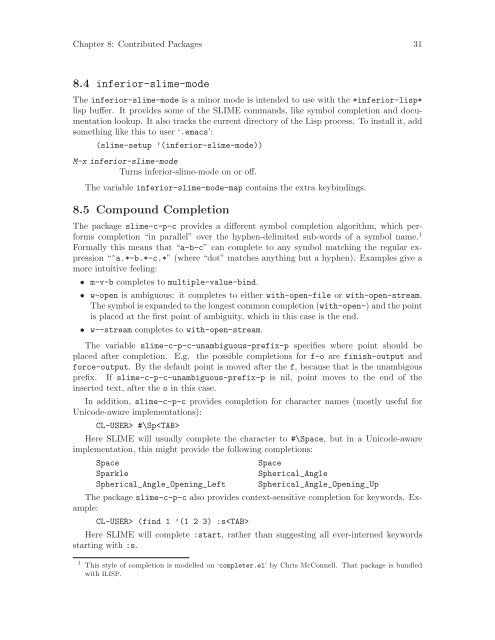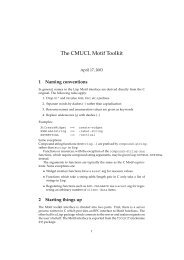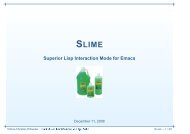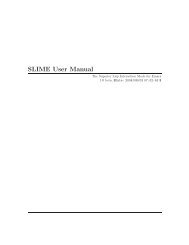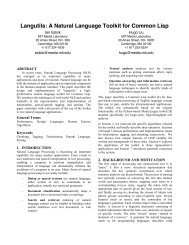SLIME User Manual version 3.0-alpha - Common Lisp
SLIME User Manual version 3.0-alpha - Common Lisp
SLIME User Manual version 3.0-alpha - Common Lisp
Create successful ePaper yourself
Turn your PDF publications into a flip-book with our unique Google optimized e-Paper software.
Chapter 8: Contributed Packages 31<br />
8.4 inferior-slime-mode<br />
The inferior-slime-mode is a minor mode is intended to use with the *inferior-lisp*<br />
lisp buffer. It provides some of the <strong>SLIME</strong> commands, like symbol completion and documentation<br />
lookup. It also tracks the current directory of the <strong>Lisp</strong> process. To install it, add<br />
something like this to user ‘.emacs’:<br />
(slime-setup ’(inferior-slime-mode))<br />
M-x inferior-slime-mode<br />
Turns inferior-slime-mode on or off.<br />
The variable inferior-slime-mode-map contains the extra keybindings.<br />
8.5 Compound Completion<br />
The package slime-c-p-c provides a different symbol completion algorithm, which performs<br />
completion “in parallel” over the hyphen-delimited sub-words of a symbol name. 1<br />
Formally this means that “a-b-c” can complete to any symbol matching the regular expression<br />
“^a.*-b.*-c.*” (where “dot” matches anything but a hyphen). Examples give a<br />
more intuitive feeling:<br />
• m-v-b completes to multiple-value-bind.<br />
• w-open is ambiguous: it completes to either with-open-file or with-open-stream.<br />
The symbol is expanded to the longest common completion (with-open-) and the point<br />
is placed at the first point of ambiguity, which in this case is the end.<br />
• w--stream completes to with-open-stream.<br />
The variable slime-c-p-c-unambiguous-prefix-p specifies where point should be<br />
placed after completion. E.g. the possible completions for f-o are finish-output and<br />
force-output. By the default point is moved after the f, because that is the unambigous<br />
prefix. If slime-c-p-c-unambiguous-prefix-p is nil, point moves to the end of the<br />
inserted text, after the o in this case.<br />
In addition, slime-c-p-c provides completion for character names (mostly useful for<br />
Unicode-aware implementations):<br />
CL-USER> #\Sp<br />
Here <strong>SLIME</strong> will usually complete the character to #\Space, but in a Unicode-aware<br />
implementation, this might provide the following completions:<br />
Space Space<br />
Sparkle Spherical_Angle<br />
Spherical_Angle_Opening_Left Spherical_Angle_Opening_Up<br />
The package slime-c-p-c also provides context-sensitive completion for keywords. Example:<br />
CL-USER> (find 1 ’(1 2 3) :s<br />
Here <strong>SLIME</strong> will complete :start, rather than suggesting all ever-interned keywords<br />
starting with :s.<br />
1 This style of completion is modelled on ‘completer.el’ by Chris McConnell. That package is bundled<br />
with ILISP.


